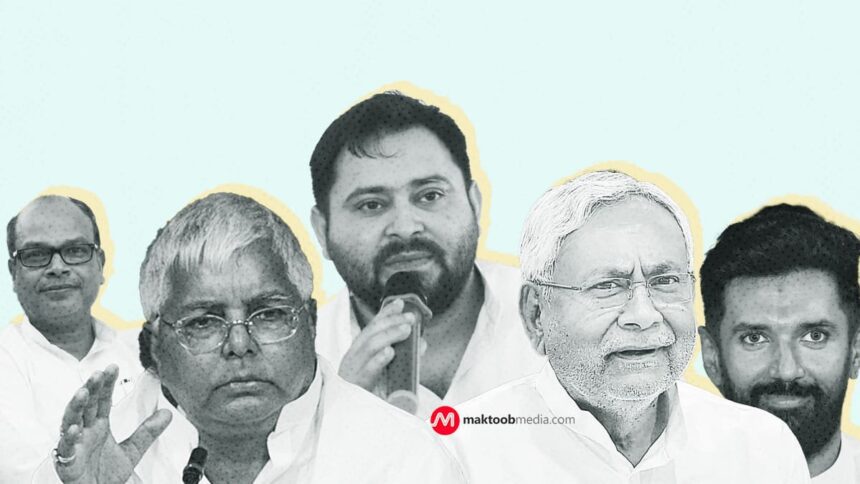As the Bihar Assembly elections approach, the political climate is charged in this populous state, which has a population exceeding 120 million. With all 243 seats in the Vidhan Sabha on the line, this election is not only a regional affair but also serves as a litmus test for opposition unity against the Bharatiya Janata Party’s (BJP) dominance in the Hindi heartland. Currently, the National Democratic Alliance (NDA), comprising the BJP, Janata Dal (United) [JD(U)], Lok Janshakti Party (Ram Vilas), the Hindustani Awaam Morcha (HAM), and smaller allies, is led by Chief Minister Nitish Kumar, who is grappling with increased anti-incumbency sentiment following a lengthy and inconsistent tenure. Meanwhile, the INDIA bloc, spearheaded by the Rashtriya Janata Dal (RJD), Congress, the VIP, and Left parties, strives to harness the frustrations of the youth, economic challenges, and evolving caste dynamics for a comeback.
Prashant Kishor’s Jan Suraaj Party is a wildcard in this election, contesting all available seats and proposing governance reforms that may disrupt traditional voting patterns. The 2024 Lok Sabha elections saw the NDA win 30 of 40 seats, albeit with diminishing margins, indicating a contentious electoral landscape ahead. Campaign issues include unemployment, out-migration, the implications of the caste census, and welfare programs, with crucial demographics such as Yadavs, Kurmis, Koeris/Kushwahas, Extremely Backward Classes (EBCs), Scheduled Castes (SCs), and Muslims shaping the outcome.
Historical and Caste Dynamics
Bihar’s electoral history is intricately linked to caste politics, which has evolved from upper-caste dominance to an era of empowerment among backward castes. Post-independence, the Congress party largely represented upper-caste interests. However, the social justice movements of the 1970s and 1980s led to the Mandal Commission’s recommendations in the 1990s, allocating 27% of government jobs and educational opportunities to Other Backward Classes (OBCs). This shift fostered leaders such as Lalu Prasad Yadav of the RJD and Nitish Kumar of JD(U), focused on land reforms and social equity. The establishment of the “Luv-Kush” alliance, uniting the Kurmis and Koeris/Kushwahas, weakened Yadav’s hold and facilitated Nitish’s collaboration with the BJP in 2005, ending the RJD’s 15-year governance era based on promises of development.
However, Nitish’s history of shifting alliances—partnering with the Mahagathbandhan in 2015, reverting back to the NDA in 2017, and a brief alliance switch in 2022—has resulted in voter skepticism. In the 2020 elections, during the crises of COVID-19 and the resultant migrant situation, the NDA secured 125 seats against the Mahagathbandhan’s 110, underscoring Bihar’s tumultuous political environment.
The 2023 Bihar Caste Census has highlighted these shifting dynamics: OBCs and EBCs comprise 63.14% of the population, SCs account for 19.65%, STs for 1.68%, and upper castes for 15.52%. Yadavs make up 14.26%, Muslims 17.70%, and EBCs a significant 36.01%. Additionally, Kurmis and Koeris/Kushwahas account for 2.87% and 4.27%, respectively, with upper castes like Brahmins (3.7%), Bhumihars (2.9%), and Rajputs (3.4%) typically inclined towards the BJP.
The Luv-Kush bloc, representing about 7-8% of voters but concentrated in over 70 constituencies, has proven pivotal for Nitish, aiding the NDA’s success in 2010 with 206 seats. Yet, by the 2024 elections, signs of erosion emerged as candidates from the INDIA alliance began encroaching on traditionally strong NDA territories. EBCs remain unpredictable and are often influenced by Nitish’s policies, while SCs are divided, with around one-third of Paswans supporting Chirag Paswan’s LJP(RV), leaving others still searching for clarity.
Women voters, who constitute nearly half the electorate, are leaning towards the NDA, driven by measures such as the liquor ban and cash transfers to women under the Bihari job scheme. The 2020 Lokniti-CSDS post-poll survey indicated OBC support at 59%, with Yadavs predominantly backing the RJD (83%) while Kurmis and Koeris wavered towards the NDA (60-65%), and upper castes showed support for the BJP (32.2%), establishing a nuanced caste landscape for the upcoming elections.
Alliances and Strategies
The NDA, founded on pragmatic collaboration, faces internal tensions as it strives to maintain stability. The JD(U), which garnered 43 seats in 2020, leans on Nitish’s appeal to the Luv-Kush and EBC communities, recently promoting 36 Kurmi-Koeri leaders and 19 EBCs to balance caste representation. Amidst speculation regarding Nitish’s health and possible successors—including his son, Nishant—there are concerns about future leadership.
The BJP, holding 74 seats, forms the alliance’s backbone, utilizing its extensive RSS network to promote urban development. Samrat Choudhary, a Kushwaha, has been appointed as state president and deputy chief minister, with district restructuring aimed at integrating Luv-Kush leaders while securing positions for upper caste members. To enhance outreach to the Paswan community, the BJP has forged alliances with Chirag Paswan, alongside smaller partners like HAM to bolster support among SCs. Initiatives such as the Pradhan Mantri Kisan Samman Nidhi and free electricity promises are cornerstones of their strategy, alongside a significant pledge made by Prime Minister Modi of ₹10,000 for 7.5 million women under the Mukhyamantri Mahila Rojgar Yojana.
Amit Shah’s campaigns targeting 68 vulnerable constituencies emphasize security concerns, risking the JD(U)’s appeal within Muslim demographics. The NDA’s slogan, “Do hazar pachhees, phir se Nitish,” seeks to instill a sense of stability, though the BJP’s dominance in cabinet portfolios stirs discontent. BJP leader Dharmendra Pradhan, tasked with overseeing the elections, is also involved in a candidate review that may see 15-18 incumbents replaced based on electability.
Conversely, the INDIA bloc aims to recover from its 110-seat performance in 2020, under the energetic leadership of Tejashwi Yadav, while shifting from Lalu’s legacy to pledges of job creation and loan waivers for farmers. The RJD is fortifying its Yadav-Muslim coalition with the MY-BAAP strategy, targeting EBCs and women. Key appointments, such as EBC leader Mangani Lal Mandal as state chief and outreach to Luv-Kush constituents, have begun yielding electoral gains.
The Congress party, with 19 seats, is consolidating its presence in Muslim-majority areas, while the CPI(ML) leads efforts to mobilize Dalits in Magadh. The INDIA coalition is stressing the NDA’s shortcomings regarding employment—a critical issue for 20% of voters—and migration, while advocating for increased OBC quotas and utilizing the caste census to address these disparities. Rahul Gandhi’s Vote Adhikar Yatra aims to galvanize support from OBCs and Dalits, calling attention to issues of social justice and economic equity. However, internal conflicts regarding seat-sharing and Congress’s factionalism pose significant obstacles.
Emerging players like Kishor’s Jan Suraaj are staking claims in all constituencies, aiming to engage urban youth with their governance promises, yet they struggle to penetrate rural areas dominated by caste considerations. The AIMIM’s participation in the Muslim-majority Seemanchal region poses risks of fragmentation for the INDIA alliance. Each party is actively courting the Luv-Kush electorate; the BJP is launching Luv-Kush Yatras, JD(U)’s Nitish Kumar is making overtures, while the RJD is strategically inducting new members. In the 2020 elections, approximately 60-65% of the Luv-Kush vote favored the NDA, but shifting dynamics may make them pivotal in the upcoming elections, particularly in about 70 constituencies.
Key Issues and Campaign Dynamics
The NDA’s strategy emphasizes development and stability, focusing on infrastructure and welfare initiatives while leveraging census data to frame benefits for OBCs. Conversely, the INDIA bloc taps into anti-incumbency sentiments, advocating for job creation and social equity, resonating with disenchanted youth. Regional tactics are taking shape: the NDA presents a strong front in Mithila, while the INDIA bloc dominates Saran, with Kosi remaining contested. Women voters are pivotal, swayed by the NDA’s liquor ban and welfare programs, as electoral roll issues affect migrant voters.
With nearly 40% of Bihar’s voters below 30, youth involvement will be crucial in the 2025 Assembly Elections. Their concerns regarding unemployment and deteriorating infrastructure—like inadequate educational and healthcare facilities—are fueling strong anti-incumbency feelings. Seasonal floods remain a devastating challenge for farmers, and skepticism surrounds the NDA’s commitment to flood relief despite promises of ₹10,000 crore.
The NDA is banking on Prime Minister Narendra Modi’s popularity, presenting initiatives such as the Mukhyamantri Mahila Rojgar Yojana, which provides ₹10,000 to 75 lakh women to promote self-employment, alongside a ₹568 crore investment in youth sports and free electricity for low consumers. Nitish’s campaign is tailored to address women, youth, minorities, and educators, while Amit Shah’s rallies in Mithila are designed to secure EBC support. In contrast, the INDIA bloc, under Rahul Gandhi and Tejashwi Yadav, is pushing their ‘Ati Pichhda Nyay Sankalp’ manifesto, which includes new protections for EBCs, reservations in local bodies, and land rights for the landless, alongside Tejashwi’s Mai-Behen Maan Yojana that offers ₹2,500 monthly to underprivileged women.
The 2025 Bihar elections showcase the complexities of Indian democracy, where caste affiliations, political alliances, and public aspirations converge. A victory for the NDA would cement the BJP’s foothold in the heartland, reflecting Nitish’s enduring legacy. Conversely, an INDIA triumph would signal a resurgence of opposition forces. However, beyond demographic statistics, Bihar requires effective strategies to address unemployment and migration to secure a more prosperous future. The outcome of this election will resonate far beyond state lines, influencing broader Indian political trajectories.
Aamir Raza, an independent researcher based in New Delhi, has previously collaborated with Lokniti-CSDS and IIT Delhi. His research focuses on electoral politics, representation, minority studies, ethnic politics, and democratization.
Tags: Bihar 2025, political alliances, power struggle, Bihar politics, 2025 elections
Hashtags: #Unravelling #Bihar #Alliances #ambitions #fight #power










